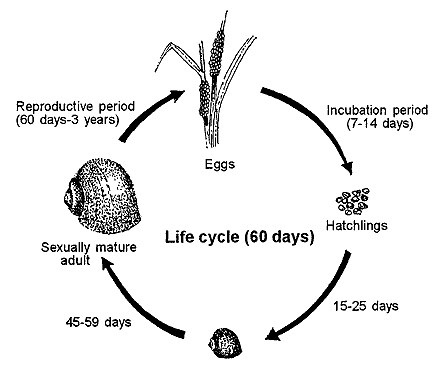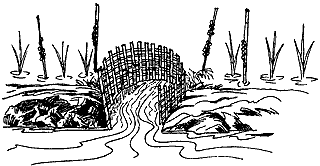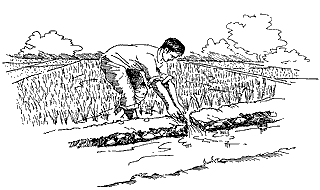|
Management options for the Golden
Apple Snail
|
|
 |
Foreword
The golden apple snail, popularly known as "golden kuhol'' [Pomacea canaliculata
Lamarck], is one of the major pest problems in rice production. In 1989, the
Food and Agriculture Organization of the United Nations estimated that yield
tosses owing to this pest ranged from 1% to 40% of the planted area in the Philippines,
resulting in huge production loss.
To control this pest, many farmers resort to the massive use of synthetic molluscicides
that are expensive and broad spectrum, affecting non-target organisms including
human beings.
This primer was prepared to present additional alternatives and information
on golden apple snail management. It contains many new information to reduce
the misuse of molluscicides. Discussed here are details of the biology of golden
apple snail, including several management options that farmers could use to
manage this pest in their farms.
A new recipe for golden apple snail is now available. The product is a chicharon
(cracker) that is devoid of water, has no offensive odor, with longer shelf-life,
and can be readily used as an ingredient in other recipes.
We hope that this primer wilt help our agricultural technicians, extension workers,
and farmers better understand the nature, spread, and management options for
golden apple snail.
 Leocadio S. Sebastian Executive Director |
Introduction
The golden apple snail, popularly known as "golden kuhol" [Pomacea
canaliculata Lamarck], was introduced into the Philippines between 1982 and
1984. It came from South America (Brazil and Argentina) via Taiwan. Its high
nutritive value as food for human beings and farm animals generated interest
among both public and private sectors to propagate the production of this organism.
However, a few years after its introduction, the golden apple snail became a
major pest of rice.
Of the 3 million (M) hectares of rice lands in the Philippines, 1.2-1.6M hectares
are infested with golden apple snail. In 1990, P212M was spent to control this
pest. The first account that it had become a major pest was recorded in 1986
when about 300 hectares of irrigated rice farms in Region 2 (Cagayan Valley)
were heavily damaged. Since then, rice area infested with this pest has been
increasing until it became a national menace.
Characteristics of adult golden apple snails
The golden apple snail lives for 2-6 years with high fertility.
Shell is tight brown; flesh is creamy white to golden pinkish or orange.
Size depends on the availability of food.
Most destructive stage is when the length of the shell is from 10 mm (about
the size of a corn seed) to 40 mm (about the size of a pingpong ball).*
Female golden apple snail operculum (a1) is concave white it is convex in male
(a2).
The shell of the female adult snail (b1) curves inward; the male shell (b2)
curves outward.*
Based on the study conducted by MS Dela Cruz, RC Joshi, and AR Martin.
 |
 |
Hatchlings and adults
Naturally occurring biological control agents
 |
During land preparation
 |
 Small canals, where the golden apple snails will seek refuge if water level is critical, make collection easier. |
 Screens on the water inlet reduce entry of golden snails to the paddy. |
During transplanting
 Draining the field occasionally will limit snail mobility and feeding activity. |
 Handpicking is recommended for large adult golden snails as these are not fed upon by ducks. |
After harvesting
|
|
Integrated management scheme based on rice growth stages
|
|||||||||||||||
| A = Duck pasturing, handpicking, constructing canalets, use of plant attractants and destruction of egg masses | |||||||||||||||
| B = Handpicking, duck pasturing, screen trapping, staking, and destruction of egg masses | |||||||||||||||
| C = Water management, handpicking, use of plant attractants, and destruction of egg masses | |||||||||||||||
| D = Sustain handpicking and destruction of adults and eggs | |||||||||||||||
|
E
= Duck pasturing, dry Land preparation
|
|||||||||||||||
A study conducted by researchers MS Dela Cruz, RC Joshi, and AR Martin from 1999 to 2000 at PhilRice Maligaya found the following:
Nutritive value of golden apple snail
Nutritive value of golden apple snail flesh per 100g
- Food energy 83 calories
- Protein 12.2 g
- Fat 0.4 g
- Carbohydrates 6.6 g
- Ash 3.2 g
- Phosphorus 61 mg
- Sodium 40 mg
- Potassium 17 mg
- Riboflavin 12 mg
- Niacin 1.8 mg
- Other food values: Vit. C, zinc, copper, manganese, and iodine
List of Fertilizer and Pesticide Authority-registered molluscicides
as of 31 March 2000
|
Formulation
type |
Active
Ingredient |
Product
Name |
Concen-
tration |
Label Recom-
bination |
Toxicity
Category * |
Company
|
|
P
|
Metaldehyde
|
Metabait
6% Pellets |
60 g/kg
|
2-4 kg/ha
4-8 kg/ha |
4
|
Agchem Mftg.
Corp. |
|
F
|
Metaldehyde
|
Meta Flo
|
300 g/L
|
16-20 tbps
/16L water |
2
|
|
|
WP
|
Metaldehyde
|
Porsnail
74 WP |
750 g/kg
|
10 tbsp/16L
water |
||
|
G
|
Metaldehyde
|
Rescue
10 G |
100 g/kg
|
|||
|
P
|
Metaldehyde
|
SnailKil
6% P |
60 g/kg
|
2-4 kg/ha(T)
4-8 kg/ha(DS) |
4
|
|
|
F
|
Chlorothalonil
|
Shield
|
500 g/L
|
4
|
Aldiz Inc.
|
|
|
EC
|
Niclosamide
|
Bayluscide
250 EC |
250 g/L
|
7-14 tbsp/16L
water |
4
|
Bayer Phils., Inc.
|
|
WP
|
Bayluscide
70 WP |
700 g/kg
|
4
|
|||
|
EC
|
Niclosamide
|
Hit 250 EC
|
250 g/L
|
7-14 tbsp/16L
water |
4
|
Cropking
Chem., Inc. |
|
WP
|
Niclosamide
|
Trap 70 WP
|
700 g/kg
|
35 g/16L water
|
4
|
Dow Agro
Sciences B.V., Phils. |
|
PEL
|
Metaldehyde
|
Bayonet
6% Pellets |
60g/kg
|
2-4 kg/ha(T)
4-8 kg/ha(DS) |
4
|
Jardine Davies;
Inc. |
|
PEL
|
Metaldehyde
|
Stop 6%
Pellets |
60 g/kg
|
2-4 kg/ha(T)
4-8 kg/ha(DS) |
4
|
Leads Agri
Product Corp. |
|
WP
|
Niclosamide
|
Archer
50WP |
500 g/kg
|
4
|
Nichimen Corp.
|
|
|
PEL
|
Metaldehyde
|
Ciba Meta
Bait |
60 g/kg
|
2-4 kg/ha(T)
4-8 kg/ha(DS) |
4
|
Novartis Agro
Phils., Inc. |
|
F
|
Metaldehyde
|
Meta Flo
600 FL |
300 g/L
|
16-20 tbsp/16L
water |
2
|
|
|
P
|
Tannins,
Glycosides, Sterols, and Flavanoids |
Kuhol P
|
245 g/kg
|
20 kg/ha
|
4
|
Pro Green
Phils., Inc. |
|
EC
|
Niclosamide
|
Moluxide
250 EC |
250g/L
|
7-14 tbsp/16L
water |
4
|
Transworld
Trdg. |
EC - Emulsiflable Concentrate, F - Flowable, G - Granule,
P - Powder, PEL - Pellet, WP - Wettable Powder, T
- Transplanted, DS - Direct Seeded, tbsp - tablespoon.
*Based on World Health Organization, classification by hazards: 2 - moderately
hazardous; 4 - unlikely to present acute hazard in normal case
For more information, contact:
Crop Protection Division
Philippine Rice Research Institute
Maligaya, Science City of Munos, 3119 Nueva Ecija
Tel. Nos.: (044) 456-0285; -0113 local 227
Published 2001 by the Philippine Rice Research Institute. Readers are
encouraged to reproduce the contents of this bulletin with
acknowledgment.
About DA-PhilRice
The Philippine Rice Research Institute (PhilRice) is a government corporation
attached to the
Department of Agriculture (DA). Executive Order 1061 approved on November 5,
1985 and
amended by EO 60 dated Nov. 7, 1986 created PhilRice to help develop high-yielding
technologies
so that farmers can produce enough rice for all Filipinos. PhilRice accomplishes
this mission
through research, technology promotion, and policy advocacy, which are implemented
through a
network that includes 57 agencies and 104 seed centers strategically located
nationwide.
Its interdisciplinary programs include the following: (1) direct-seeded and
(2) transplanted
irrigated lowland rice; (3) hybrid rice; (4) rice for adverse environments;
(5) rice-based farming
systems; (6) rice and rice-based products; (7) policy research and advocacy;
and (8) technology
promotion and development. With these programs, PhilRice aims to develop and
promote
technologies that are ecosystem-based, location- and problem-specific, and profitable
to the
Filipino farmers.
Related pages on applesnail.net
![]() 'Apple
snail eradication' section, 'Apple
snails as bio-agent' section, 'Pomacea
canaliculata' section.
'Apple
snail eradication' section, 'Apple
snails as bio-agent' section, 'Pomacea
canaliculata' section.
![]() 'Apple
snails as food ' section, 'Recognizing
apple snails' section, 'Bibliography
on the golden apple snail' section.
'Apple
snails as food ' section, 'Recognizing
apple snails' section, 'Bibliography
on the golden apple snail' section.